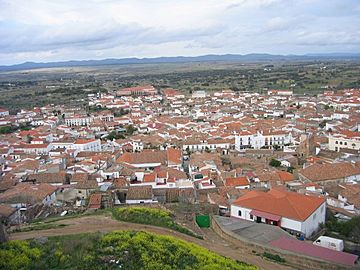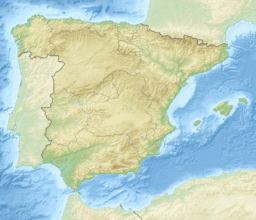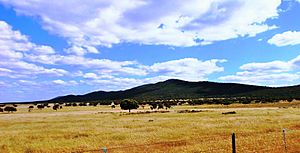Sierra de San Pedro facts for kids
Quick facts for kids Sierra de San Pedro |
|
|---|---|

View of Alburquerque with the Sierra de San Pedro in the background
|
|
| Highest point | |
| Peak | Torrico de San Pedro |
| Elevation | 702 m (2,303 ft) |
| Dimensions | |
| Length | 60 km (37 mi) NW/SE |
| Width | 15 km (9.3 mi) NE/SW |
| Area | 800 km2 (310 sq mi) |
| Geography | |
| Country | Spain |
| Range coordinates | 39°18′N 6°35′W / 39.300°N 6.583°W |
| Parent range | Montes de Toledo |
| Geology | |
| Orogeny | Alpine |
| Age of rock | Paleozoic |
| Type of rock | Granite, slate |
The Sierra de San Pedro is a mountain range in Spain. It is part of the larger Montes de Toledo mountain system. This range is named after Saint Peter, one of the apostles.
You can find the Sierra de San Pedro in the western part of Extremadura. This area is close to the border with Portugal. The range stretches across parts of Cáceres Province and Badajoz Province. The area around this mountain range is also known as the Sierra de San Pedro - Los Baldíos region.
This mountain range acts like a natural divider. It separates the rivers that flow into the Tagus River in the north. It also separates the rivers that flow into the Guadiana River in the south. Some important rivers start here. The Rivera de Aurela flows towards the Tagus. The Zapatón River flows into the Xévora River, which then goes into the Guadiana. The Sierra de San Pedro is also a special natural area. It is recognized as a Site of Community Importance in Spain.
Contents
Exploring the San Pedro Mountains
The Sierra de San Pedro is a range of low hills. It stretches for about 60 kilometers (37 miles). It runs from the northwest to the southeast. This range is next to the Serra de São Mamede in Portugal. The Portuguese range is a bit taller.
The Sierra de San Pedro is located between several towns. To the north, you'll find Arroyo de la Luz. To the south is Alburquerque. The N-630 road is to the east. To the west are the towns of Membrio and San Vicente de Alcántara. The Peña del Águila Dam is also in this range. It helps supply water to Alburquerque. A part of the range that goes north is called the Sierra de Carbajo. It's also known as Sierra de Santiago.
How High Are the Peaks?
The mountains in the Sierra de San Pedro are not super tall. Most of the highest points are around 700 meters (2,300 feet) high. This means they don't rise much above the flat land around them.
The highest point is Torrico de San Pedro, which is 702 meters (2,303 feet) tall. Other important peaks include:
- Atalaya (624 meters)
- Chorlo (624 meters)
- Morrón del Cotarro (615 meters)
- Manzano (610 meters)
Plants and Trees in the Range
The Sierra de San Pedro has plants typical of the Mediterranean region. You'll see many shrubs and scattered trees. The most common tree is the holm oak.
The area also has beautiful flowers like Asphodelus and common peony. People in this region have traditionally grown cork oak trees. They do this to get cork. This mountain range is one of the world's top cork producers. There's even a very old and huge cork oak tree here. People call it El Abuelo, which means "The Grandfather."
Wildlife and Nature
The Sierra de San Pedro is a very important place for nature. Many different animals live here. It's especially known for its birds.
Birds of the Sierra
Because of its amazing bird population, the European Union declared this range a Special Protection Area. This means it's a protected home for birds. Some of the birds you might see include:
- Spanish imperial eagle
- Cinereous vulture
- Egyptian vulture
- Golden eagle
- Short-toed snake eagle
- Black kite
- Black-winged kite
- Booted eagle
- Eurasian eagle-owl
- Peregrine falcon
- White stork
- Black stork
The range also has many bats living in its caves.
Protected Natural Areas
The International Tagus Natural Park is a large protected area. It stretches across both Spain and Portugal. This park is located right at the northern edge of the Sierra de San Pedro range.
Rocks and Geology
The rocks in the Sierra de San Pedro are very old. Most of the area is made of Paleozoic and Precambrian slates and granite. You can also find Upper Carboniferous sandstones and conglomerates in some parts of the range.
See also
 In Spanish: Sierra de San Pedro (Extremadura) para niños
In Spanish: Sierra de San Pedro (Extremadura) para niños
- Geography of Spain
- Geology of the Iberian Peninsula



